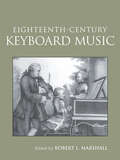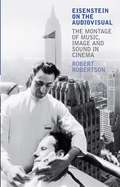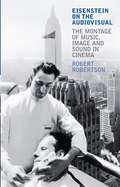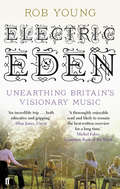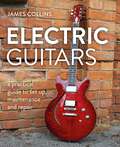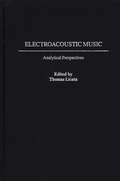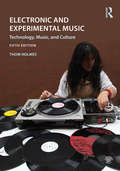- Table View
- List View
Eighteenth-Century Keyboard Music
by Robert L. MarshallFirst published in 2004. Routledge is an imprint of Taylor & Francis, an informa company.
The Eighth: Mahler and the World in 1910
by Stephen JohnsonThe Eighth Symphony was going to be different from anything Mahler had ever done before. The intensely personal dramas of his earlier symphonies were a thing of the past - or rather, they were now to be seen as preludes to this new, culminating symphonic statement: he was quite sure it was the greatest thing he had ever written. The first seven symphonies were all, in their very different ways, acts of private confession, the unburdening of a hypersensitive soul, struggling to make sense of its own existence and of the thrilling and terrifying world in which it found itself. The Eighth would speak in different tones, and of a different kind of experience. It would be a bringer of joy through inspired settings of the hymn Veni, Creator Spiritus and the final scene of Goethe's Faust. The world première in Munich in the summer of 1910 was the artistic breakthrough for which the composer had yearned all his adult life, filling Munich's huge Neue Musik-Festhalle on two successive evenings, to tumultuous applause. Stephen Johnson recounts its far-reaching effect on composers, conductors and writers of the time - Berg and Schoenberg and the teenage Korngold, Bruno Walter and Klemperer, and the writers Stefan Zweig and Thomas Mann (the character of Gustav von Aschenbach in Mann's Death in Venice was partly based on the impression Mahler made on him in 1910). Placing Mahler within his world - in particular the German-speaking world - Johnson re-assesses Mahler's thoughts in the context of the prevailing thought of his age, not only in relation to the artistic and intellectual movements of the time, but through consideration of political climate and historical background, and on into science, medicine, technology, mass entertainment, and even the development of modern PR. Throughout we are made aware that in that same tumultuous summer Mahler worked desperately on his Tenth Symphony, was betrayed by his wife, and consulted Sigmund Freud. It is a story like no other.
The Eighth: Mahler and the World in 1910
by Stephen JohnsonSeptember 12, 1910: The world premiere of Gustav Mahler’s Eighth Symphony and the artistic breakthrough for which the composer had yearned all his life. Munich’s new Musik Festhalle was filled to capacity on two successive evenings for the performances, which were received with rapturous applause. Representatives of many European royal houses were in attendance, along with an array of stars from the musical and literary world, including Thomas Mann and the young Arnold Schoenberg. Also present were Alma Mahler, the composer’s wife, and Alma’s longtime lover, the architect Walter Gropius. Knowledge of their relationship would precipitate an emotional crisis in Mahler that, compounded with his heart condition and the loss of his young daughter Maria, would lead to his premature death the next year. In The Eighth, Stephen Johnson provides a masterful account of the symphony’s far-reaching consequences and its effect on composers, conductors, and writers of the time. The Eighth looks behind the scenes at the demanding one-week rehearsal period leading up to the premiere—something unheard of at the time—and provides fascinating insight into Mahler’s compositional habits, his busy life as a conductor, his philosophical and literary interests, and his personal and professional relationships. Johnson expertly contextualizes Mahler’s work among the prevailing attitudes and political climate of his age, considering the art, science, technology, and mass entertainment that informed the world in 1910. The Eighth is an absorbing history of a musical masterpiece and the troubled man who created it.
The Eighth: Mahler and the World in 1910
by Stephen JohnsonSeptember 12, 1910: The world premiere of Gustav Mahler’s Eighth Symphony and the artistic breakthrough for which the composer had yearned all his life. Munich’s new Musik Festhalle was filled to capacity on two successive evenings for the performances, which were received with rapturous applause. Representatives of many European royal houses were in attendance, along with an array of stars from the musical and literary world, including Thomas Mann and the young Arnold Schoenberg. Also present were Alma Mahler, the composer’s wife, and Alma’s longtime lover, the architect Walter Gropius. Knowledge of their relationship would precipitate an emotional crisis in Mahler that, compounded with his heart condition and the loss of his young daughter Maria, would lead to his premature death the next year. In The Eighth, Stephen Johnson provides a masterful account of the symphony’s far-reaching consequences and its effect on composers, conductors, and writers of the time. The Eighth looks behind the scenes at the demanding one-week rehearsal period leading up to the premiere—something unheard of at the time—and provides fascinating insight into Mahler’s compositional habits, his busy life as a conductor, his philosophical and literary interests, and his personal and professional relationships. Johnson expertly contextualizes Mahler’s work among the prevailing attitudes and political climate of his age, considering the art, science, technology, and mass entertainment that informed the world in 1910. The Eighth is an absorbing history of a musical masterpiece and the troubled man who created it.
The Eighth: Mahler and the World in 1910
by Stephen JohnsonSeptember 12, 1910: The world premiere of Gustav Mahler’s Eighth Symphony and the artistic breakthrough for which the composer had yearned all his life. Munich’s new Musik Festhalle was filled to capacity on two successive evenings for the performances, which were received with rapturous applause. Representatives of many European royal houses were in attendance, along with an array of stars from the musical and literary world, including Thomas Mann and the young Arnold Schoenberg. Also present were Alma Mahler, the composer’s wife, and Alma’s longtime lover, the architect Walter Gropius. Knowledge of their relationship would precipitate an emotional crisis in Mahler that, compounded with his heart condition and the loss of his young daughter Maria, would lead to his premature death the next year. In The Eighth, Stephen Johnson provides a masterful account of the symphony’s far-reaching consequences and its effect on composers, conductors, and writers of the time. The Eighth looks behind the scenes at the demanding one-week rehearsal period leading up to the premiere—something unheard of at the time—and provides fascinating insight into Mahler’s compositional habits, his busy life as a conductor, his philosophical and literary interests, and his personal and professional relationships. Johnson expertly contextualizes Mahler’s work among the prevailing attitudes and political climate of his age, considering the art, science, technology, and mass entertainment that informed the world in 1910. The Eighth is an absorbing history of a musical masterpiece and the troubled man who created it.
The Eighth: Mahler and the World in 1910
by Stephen JohnsonSeptember 12, 1910: The world premiere of Gustav Mahler’s Eighth Symphony and the artistic breakthrough for which the composer had yearned all his life. Munich’s new Musik Festhalle was filled to capacity on two successive evenings for the performances, which were received with rapturous applause. Representatives of many European royal houses were in attendance, along with an array of stars from the musical and literary world, including Thomas Mann and the young Arnold Schoenberg. Also present were Alma Mahler, the composer’s wife, and Alma’s longtime lover, the architect Walter Gropius. Knowledge of their relationship would precipitate an emotional crisis in Mahler that, compounded with his heart condition and the loss of his young daughter Maria, would lead to his premature death the next year. In The Eighth, Stephen Johnson provides a masterful account of the symphony’s far-reaching consequences and its effect on composers, conductors, and writers of the time. The Eighth looks behind the scenes at the demanding one-week rehearsal period leading up to the premiere—something unheard of at the time—and provides fascinating insight into Mahler’s compositional habits, his busy life as a conductor, his philosophical and literary interests, and his personal and professional relationships. Johnson expertly contextualizes Mahler’s work among the prevailing attitudes and political climate of his age, considering the art, science, technology, and mass entertainment that informed the world in 1910. The Eighth is an absorbing history of a musical masterpiece and the troubled man who created it.
Eine Kleine Nachtmusik K525 third movement (PDF)
by Mozart SazThis is a musical score in Modified Stave Notation. The original file is available as .mscz format and the braille music version as .brf from mas@rnib.org.uk
„Eins zu eins ist jetzt vorbei“: Popschreibweisen seit 2000 (Kontemporär. Schriften zur deutschsprachigen Gegenwartsliteratur #14)
by Denise Dumschat-Rehfeldt Julia Ingold Christoph Jürgensen Stefan Neumann Antonius WeixlerDer Band nimmt das titelgebende Tocotronic-Zitat zum heuristischen Ausgangspunkt, um das Verhältnis von Kunst und Wirklichkeit und damit den Entwurf von ‚Realität‘ insgesamt in deutschsprachigen Popschreibweisen seit 2000 zu untersuchen. Während das literarische Feld sich in der Folge von 9/11 etwa tendenziell zu einem „Relevanten Realismus“ bekannte, wandte sich die Hamburger Schule in den frühen 2000er Jahren eher einer ästhetizistischen Hochkunstphase zu. Seit den 2010er Jahren lässt sich wiederum eine neue Welle ‚relevant realistischer‘, politisch-engagierter Popsongs erkennen.
Einstein on the Beach: Opera beyond Drama (Ashgate Interdisciplinary Studies in Opera)
by Jelena Novak John RichardsonPhilip Glass and Robert Wilson’s most celebrated collaboration, the landmark opera Einstein on the Beach, had its premiere at the Avignon Festival in 1976. During its initial European tour, Metropolitan Opera premiere, and revivals in 1984 and 1992, Einstein provoked opposed reactions from both audiences and critics. Today, Einstein is well on the way itself to becoming a canonized avant-garde work, and it is widely acknowledged as a profoundly significant moment in the history of opera or musical theater. Einstein created waves that for many years crashed against the shores of traditional thinking concerning the nature and creative potential of audiovisual expression. Reaching beyond opera, its influence was felt in audiovisual culture in general: in contemporary avant-garde music, performance art, avant-garde cinema, popular film, popular music, advertising, dance, theater, and many other expressive, commercial, and cultural spheres. Inspired by the 2012–2015 series of performances that re-contextualized this unique work as part of the present-day nexus of theoretical, political, and social concerns, the editors and contributors of this book take these new performances as a pretext for far-reaching interdisciplinary reflection and dialogue. Essays range from those that focus on the human scale and agencies involved in productions to the mechanical and post-human character of the opera’s expressive substance. A further valuable dimension is the inclusion of material taken from several recent interviews with creative collaborators Philip Glass, Robert Wilson, and Lucinda Childs, each of these sections comprising knee plays, or short intermezzo sections resembling those found in the opera Einstein on the Beach itself. The book additionally features a foreword written by the influential musicologist and cultural theorist Susan McClary and an interview with film and theater luminary Peter Greenaway, as well as a short chapter of reminiscences written by the singer-songwriter Suzanne Vega.
Einstein on the Beach: Opera beyond Drama (Ashgate Interdisciplinary Studies in Opera)
by Jelena Novak John RichardsonPhilip Glass and Robert Wilson’s most celebrated collaboration, the landmark opera Einstein on the Beach, had its premiere at the Avignon Festival in 1976. During its initial European tour, Metropolitan Opera premiere, and revivals in 1984 and 1992, Einstein provoked opposed reactions from both audiences and critics. Today, Einstein is well on the way itself to becoming a canonized avant-garde work, and it is widely acknowledged as a profoundly significant moment in the history of opera or musical theater. Einstein created waves that for many years crashed against the shores of traditional thinking concerning the nature and creative potential of audiovisual expression. Reaching beyond opera, its influence was felt in audiovisual culture in general: in contemporary avant-garde music, performance art, avant-garde cinema, popular film, popular music, advertising, dance, theater, and many other expressive, commercial, and cultural spheres. Inspired by the 2012–2015 series of performances that re-contextualized this unique work as part of the present-day nexus of theoretical, political, and social concerns, the editors and contributors of this book take these new performances as a pretext for far-reaching interdisciplinary reflection and dialogue. Essays range from those that focus on the human scale and agencies involved in productions to the mechanical and post-human character of the opera’s expressive substance. A further valuable dimension is the inclusion of material taken from several recent interviews with creative collaborators Philip Glass, Robert Wilson, and Lucinda Childs, each of these sections comprising knee plays, or short intermezzo sections resembling those found in the opera Einstein on the Beach itself. The book additionally features a foreword written by the influential musicologist and cultural theorist Susan McClary and an interview with film and theater luminary Peter Greenaway, as well as a short chapter of reminiscences written by the singer-songwriter Suzanne Vega.
Einstürzende Neubauten's Kollaps (33 1/3 Europe)
by Melle Jan Kromhout Jan NieuwenhuisPerhaps the best musical encapsulation of the Cold War as experienced in the walled city of West-Berlin, Kollaps is a product of its time while remaining as vital, exhilarating and surprising as the day it was released.The book explores the contexts, themes and influences that shaped Kollaps. It describes the early days of Einstürzende Neubauten in West-Berlin, their infamous live performances and guerilla style recording tactics, and the scrap metal banging, piercing guitar noise and evocative lyricism that went on to inspire generations of fans. Most significantly, it explores the desire and deep sense of belonging that is expressed by what Nick Cave called the 'incredibly mournful, haunting' nature of this music. The beginning of a 40-year career, this first burst of energy remains their purest statement.
Einstürzende Neubauten's Kollaps (33 1/3 Europe)
by Melle Jan Kromhout Jan NieuwenhuisPerhaps the best musical encapsulation of the Cold War as experienced in the walled city of West-Berlin, Kollaps is a product of its time while remaining as vital, exhilarating and surprising as the day it was released.The book explores the contexts, themes and influences that shaped Kollaps. It describes the early days of Einstürzende Neubauten in West-Berlin, their infamous live performances and guerilla style recording tactics, and the scrap metal banging, piercing guitar noise and evocative lyricism that went on to inspire generations of fans. Most significantly, it explores the desire and deep sense of belonging that is expressed by what Nick Cave called the 'incredibly mournful, haunting' nature of this music. The beginning of a 40-year career, this first burst of energy remains their purest statement.
Eisenstein on the Audiovisual: The Montage of Music, Image and Sound in Cinema
by Robert RobertsonThe pioneering film director and theorist Sergei Eisenstein is known for the unequalled impact his films have had on the development of cinema. Less is known about his remarkable and extensive writings, which present a continent of ideas about film. Robert Robertson presents a lucid and engaging introduction to a key area of Eisenstein's thought: his ideas about the audiovisual in cinema, which are more pertinent today than ever before. With the advent of digital technology, music and sound now act as independent variables combined with the visual medium to produce a truly audiovisual result. Eisenstein explored in his writings this complex, exciting subject with more depth and originality than any other practitioner, and this is an accessible and original exploration of his ideas. Winner of the Kraszna Krausz Foundation's And/Or Award for Best Moving Image Book of 2009, "Eisenstein on the Audiovisual" is essential reading for students and practitioners of the audiovisual in cinema and related audiovisual forms, including theatre, opera, dance and multimedia.
Eisenstein on the Audiovisual: The Montage of Music, Image and Sound in Cinema (International Library of Cultural Studies #Vol. 5)
by Robert RobertsonEisenstein on the Audiovisual is winner of the Kraszna-Krausz Foundation's And/Or Award for the Best Moving Image Book of 2009. Chair of the judging panel Francine Stock commented: 'We had no hesitation in choosing the winner. Composer and filmmaker Robert Robertson achieves the near-impossible, shedding fresh light on Eisenstein without loading him with ideology. Like the work it describes, this book is symphonic; it draws together strong influences and forces around Eisenstein into a compelling and cogent narrative - at once enjoyable, provocative.'
Electric Eden: Unearthing Britain's Visionary Music
by Rob YoungElectric Eden documents one of the great untold stories of British music over the past century. While ostensibly purporting to be a history of that much derided (though currently fashionable) four-letter word, 'folk', Electric Eden will be a magnificent survey of the visionary, topographic and esoteric impulses that have driven the margins of British visionary folk music from Vaughan Williams and Holst to The Incredible String Band, Nick Drake, John Martyn and Aphex Twin. For the first time the full story of the extraordinary period of folk rock from the mid 1960s to the mid 1970s will be told in a book with the breadth of a social history touching on sonic worship, pagan architecture, land art, ley lines and ther outer fringes of the avant garde. Electric Eden identifies a particularly English wellspring of imagery and imagination, an undercurrent that has fed into the creative and organic strand of Britain's music over the past century. From Edwardian composers assimilations of folk song and visionary poetry, via folk rock of the 60s and 70s, the story is brought up to date by placing these earlier movements in a continuum that links through significant figures in 21st century pastoral electronica.
Electric Folk: The Changing Face of English Traditional Music
by Britta SweersIn the 1960s and 1970s, a number of British musicians rediscovered traditional folk ballads, fusing the old melodies with rock, jazz, and blues styles to create a new genre dubbed "electric folk" or "British folk rock." This revival featured groups such as Steeleye Span, Fairport Convention, and Pentangle and individual performers like Shirley & Dolly Collins, and Richard Thompson. While making music in multiple styles, they had one thing in common: they were all based on traditional English song and dance material. These new arrangements of an old repertoire created a unique musical voice within the popular mainstream. After reasonable commercial success, peaking with Steeleye Span's Top 10 album All Around My Hat, Electric Folk disappeared from mainstream notice in the late 1970s, yet performers continue to create today. In Electric Folk: The Changing Face of English Traditional Music, Britta Sweers provides an illuminating history and fascinating analysis of the unique features of the electric folk scene, exploring its musical styles and cultural implications. Drawing on rare historical sources, contemporary music journalism, and first-hand interviews with several of electric folk's most prominent artists, Sweers argues that electric folk is both a result of the American folk revival of the early 1960s and a reaction against the dominance of American pop music abroad. Young British "folk-rockers," such as Richard Thompson and Maddy Prior, turned to traditional musical material as a means of asserting their British cultural identity. Yet, unlike many American and British folk revivalists, they were not as interested in the "purity" of folk ballads as in the music's potential for lively interaction with modern styles, instruments, and media. The book also delves into the impact of the British folk rock movement on mainstream pop, American rock music, and neighboring European countries. Ultimately, Sweers creates a richly detailed portrait of the electric folk scene--as cultural phenomenon, commercial entity, and performance style.
Electric Folk: The Changing Face of English Traditional Music
by Britta SweersIn the 1960s and 1970s, a number of British musicians rediscovered traditional folk ballads, fusing the old melodies with rock, jazz, and blues styles to create a new genre dubbed "electric folk" or "British folk rock." This revival featured groups such as Steeleye Span, Fairport Convention, and Pentangle and individual performers like Shirley & Dolly Collins, and Richard Thompson. While making music in multiple styles, they had one thing in common: they were all based on traditional English song and dance material. These new arrangements of an old repertoire created a unique musical voice within the popular mainstream. After reasonable commercial success, peaking with Steeleye Span's Top 10 album All Around My Hat, Electric Folk disappeared from mainstream notice in the late 1970s, yet performers continue to create today. In Electric Folk: The Changing Face of English Traditional Music, Britta Sweers provides an illuminating history and fascinating analysis of the unique features of the electric folk scene, exploring its musical styles and cultural implications. Drawing on rare historical sources, contemporary music journalism, and first-hand interviews with several of electric folk's most prominent artists, Sweers argues that electric folk is both a result of the American folk revival of the early 1960s and a reaction against the dominance of American pop music abroad. Young British "folk-rockers," such as Richard Thompson and Maddy Prior, turned to traditional musical material as a means of asserting their British cultural identity. Yet, unlike many American and British folk revivalists, they were not as interested in the "purity" of folk ballads as in the music's potential for lively interaction with modern styles, instruments, and media. The book also delves into the impact of the British folk rock movement on mainstream pop, American rock music, and neighboring European countries. Ultimately, Sweers creates a richly detailed portrait of the electric folk scene--as cultural phenomenon, commercial entity, and performance style.
Electric Guitars: A Practical Guide to Set Up, Maintenance and Repair
by James CollinsThis practical guide considers everything you need to know, from the instrument's initial set up through to maintenance and repairs. An invaluable resource for beginners who want to learn to set up and look after their guitars, to aspiring and professional touring techs who want to work on other people's guitars.
Electric Shock: From the Gramophone to the iPhone – 125 Years of Pop Music
by Peter DoggettAmbitious and groundbreaking, Electric Shock tells the story of popular music, from the birth of recording in the 1890s to the digital age, from the first pop superstars of the twentieth century to the omnipresence of music in our lives, in hit singles, ringtones and on Spotify. Over that time, popular music has transformed the world in which we live. Its rhythms have influenced how we walk down the street, how we face ourselves in the mirror, and how we handle the outside world in our daily conversations and encounters. It has influenced our morals and social mores; it has transformed our attitudes towards race and gender, religion and politics. From the beginning of recording, when a musical performance could be preserved for the first time, to the digital age, when all of recorded music is only a mouse-click away; from the straitlaced ballads of the Victorian era and the ‘coon songs’ that shocked America in the early twentieth century to gangsta rap, death metal and the multiple strands of modern dance music: Peter Doggett takes us on a rollercoaster ride through the history of music. Within a narrative full of anecdotes and characters, Electric Shock mixes musical critique with wider social and cultural history and shows how revolutionary changes in technology have turned popular music into the lifeblood of the modern world.
Electro Swing: Resurrection, Recontextualisation, and Remix (Ashgate Popular and Folk Music Series)
by Chris InglisElectro swing is a relatively recent musical style and scene which combines the music of the swing era with that of the age of electronic dance music. Chris Inglis considers key questions about electro swing’s place in contemporary society, including what it may mean for a contemporary genre to be so reliant upon the influences of the past; the different ways in which jazz may be presented to a modern audience; how one may go about defining jazz in todays postmodern world; and how this emergent genre may be analysed in terms of the wider issues of race and class consumption.
Electro Swing: Resurrection, Recontextualisation, and Remix (Ashgate Popular and Folk Music Series)
by Chris InglisElectro swing is a relatively recent musical style and scene which combines the music of the swing era with that of the age of electronic dance music. Chris Inglis considers key questions about electro swing’s place in contemporary society, including what it may mean for a contemporary genre to be so reliant upon the influences of the past; the different ways in which jazz may be presented to a modern audience; how one may go about defining jazz in todays postmodern world; and how this emergent genre may be analysed in terms of the wider issues of race and class consumption.
Electroacoustic Music: Analytical Perspectives (Contributions to the Study of Music and Dance)
by Thomas LicataElectroacoustic music, a flourishing medium for over half a century, remains today, in a wide array of technological forms, one of the major areas of creative activity in music. However, it has long been overlooked in theoretical studies—possibly in part because it does away with traditional scores and notation. In this landmark collection, a group of distinguished composers and theorists who have actively worked in the field present detailed analyses of important electroacoustic works while also demonstrating some recent approaches to the analysis of the music of this medium. Included here are discussions of such significant works as Karlheinz Stockhausen's Gesang der Jünglinge (1955/56), Iannis Xenakis' Diamorphoses (1957), and Jean-Claude Risset's Contours (1982). Overall, the collection aims to elucidate the sonic design of each of the electroacoustic music works under investigation, using its best examples as a lens through which to examine an unduly neglected genre.Demonstrating recent techniques in the analysis of electroacoustic music, the volume also considers various compositional approaches as well as computer applications that have become an irreplaceable tool in the composing of this music. So little has been written about this 20th-century art form that Electroacoustic Music: Analytical Perspectives is at once a fresh, bold step forward in musicology and analysis.
Electronic and Computer Music
by Peter ManningIn this new edition of the classic text on the evolution of electronic music, Peter Manning extends the definitive account of the medium from its birth to include key developments from the dawn of the 21st century to the present day. The scope of the many developments that have taken place since the late 1990s are considered in a series of new and updated chapters, including topics such as the development of the digital audio workstation, laptop music, the Internet, and the emergence of new performance interfaces. Emphasizing the functional characteristics of emerging technologies and their influence on the creative development of the medium, Manning covers key developments in both commercial and the non-commercial sectors to provide readers with the most comprehensive resource available on the evolution of this ever-expanding area of creativity.
Electronic and Experimental Music: Technology, Music, and Culture (Media And Popular Culture Ser.)
by Thom HolmesElectronic and Experimental Music: Technology, Music, and Culture provides a comprehensive history of electronic music, covering key composers, genres, and techniques used in analog and digital synthesis. This textbook has been extensively revised with the needs of students and instructors in mind. The reader-friendly style, logical organization, and pedagogical features of the fifth edition allow easy access to key ideas, milestones, and concepts. New to this edition: • A companion website, featuring key examples of electronic music, both historical and contemporary. • Listening Guides providing a moment-by-moment annotated exploration of key works of electronic music. • A new chapter—Contemporary Practices in Composing Electronic Music. • Updated presentation of classic electronic music in the United Kingdom, Italy, Latin America, and Asia, covering the history of electronic music globally. • An expanded discussion of early experiments with jazz and electronic music, and the roots of electronic rock. • Additional accounts of the vastly under-reported contributions of women composers in the field. • More photos, scores, and illustrations throughout. The companion website features a number of student and instructor resources, such as additional Listening Guides, links to streaming audio examples and online video resources, PowerPoint slides, and interactive quizzes.
Electronic and Experimental Music: Technology, Music, and Culture
by Thom HolmesElectronic and Experimental Music: Technology, Music, and Culture provides a comprehensive history of electronic music, covering key composers, genres, and techniques used in analog and digital synthesis. This textbook has been extensively revised with the needs of students and instructors in mind. The reader-friendly style, logical organization, and pedagogical features of the fifth edition allow easy access to key ideas, milestones, and concepts. New to this edition: • A companion website, featuring key examples of electronic music, both historical and contemporary. • Listening Guides providing a moment-by-moment annotated exploration of key works of electronic music. • A new chapter—Contemporary Practices in Composing Electronic Music. • Updated presentation of classic electronic music in the United Kingdom, Italy, Latin America, and Asia, covering the history of electronic music globally. • An expanded discussion of early experiments with jazz and electronic music, and the roots of electronic rock. • Additional accounts of the vastly under-reported contributions of women composers in the field. • More photos, scores, and illustrations throughout. The companion website features a number of student and instructor resources, such as additional Listening Guides, links to streaming audio examples and online video resources, PowerPoint slides, and interactive quizzes.
